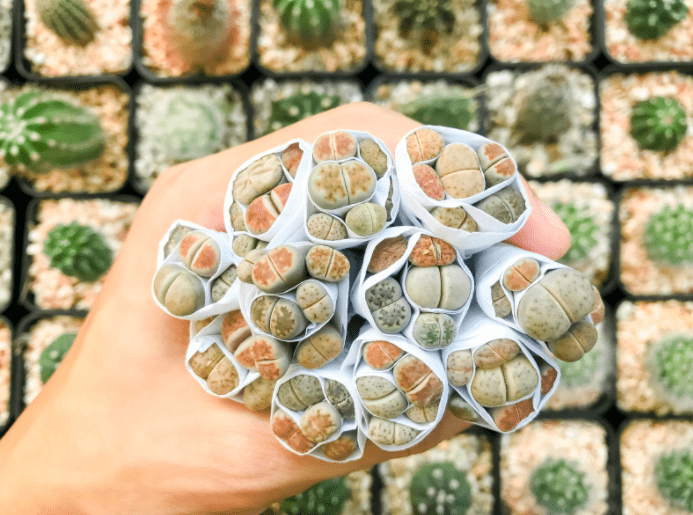Lithops Are Amazing Rock Resembling Plants
Easy-care lithops need very little water, lots of sun. Lithops are the best when there is no room on the windowsill for anything but the tiniest of plants. They are so incredibly minuscule that you have to look closely to find them.
Simple to grow, lithops nevertheless live by strict rules. Lithops, or “living stones,” are succulents from the driest regions of Africa. These unique plants have adapted grudgingly to western world cultivation but are very unforgiving about excess moisture.
Many had tried growing lithops at great expense only to be disappointed in the extreme when the plants did not adapt to the type of care they received.
How to Grow and Care for Lithops
There are only a few rules to make lithops survive happily. The primary rule is never to water them in winter — ever!
I know that when these tiny plants — the size and shape of small pebbles — are given no water, they can fade up alarmingly. However, if they are to remain alive, adherence to Rule No.1 must be strictly obeyed.
It is not uncommon to give lithops water only twice a year. They can survive up to two years without any water at all. When you do water, do it by the tablespoon, not by the cupful. Most growers will send information on watering and care with the sale of lithops.
Rule No. 2 is not as tough; these plants must have a sunny window or supplemental light. If there is no natural light fluorescent lights can be used to augment the light requirements.
Lighting is not as critical in the winter months between November and March, but the lighting becomes more critical after that. As new growth is observed, move the plants to the highest light possible.
Rule No. 3 is the simplest; fresh air must be provided for lithops to feel well. When humidity is high, this can become a real problem for lithops. If you lack access to the warm, frost-free outdoors, a fan will do the trick.
Just set the fan to low and keep it a moderate distance from the plants. Keep in mind that the fan will also dry out the air in the house. Do not try to compensate by adding moisture; this only defeats the purpose.
Propagation And Repotting
Lithops tend to have a fissure that appears to be splitting the plant in half. However, these are its leaves. From the crack, new plants and daisy-like flowers emerge.
In February, new plants will begin to emerge from this opening. Once these begin to show new growth, they should be given as much light as possible and no water until the old body shrivels and dries completely. The dry skin should shrink into the soil gradually and disappear.
When repotting lithops, the plants require at least an eight-centimeter (three-inch) depth, planted in a clay pot. Cactus soil is adequate. The roots should be below the soil, and grit should be applied to the top to support the plant’s body.
Even after you do everything right, there are the odd ones that don’t make it. Do not get discouraged.
There are excellent websites and posting boards available for lithops.
There are so many different species of lithops out there that most people feel compelled to add new ones each year.
You may want to try growing them from seed as this procedure can get you into collecting more economically. Lithops are more challenging than other plants but are well worth the effort.
Here’s more to be aware of
What is the best place to keep them?
They should be held inside the greenhouse all time to control watering needs. If they are kept out in the elements, they will receive too much rain as British summers are still too wet for them.
What kind of soil do they require to flourish?
A free-draining, loam-based growing media is required, including plenty of added sand and grit. They don’t need fertile soil.
How much water will they require?
Moderate. Don’t water from October to April, as this will provoke rotting. Thru the winter months, they will be gradually growing a new set of leaves that will sprout through the center of the old leaves.
These old leaves will wilt and die during the winter or spring. You should not make the error of believing the plant requires watering as the leaves get older and shrivel. Watering thoroughly once per month during spring and summer is sufficient.
What other unique characteristics do they possess?
Seed pods, whose opening is initiated by water.
Once wet, the seed pods slowly unfurl, creating a star shape, enabling the seed to be splashed out of the pod by rain droplets.
What is their toughness?
They can tolerate cold (down to 2-3 degrees Celsius) but are not frost hardy; They should be cultivated in a greenhouse that is kept frost-free during the winter and well ventilated in the summer.
What’s their ideal environment?
They need a sunny location, as Sun is required to etiolate (stretch as a response to the light). If growing on a windowsill, plants must be oriented to the south.
Moving the plants every week will prevent them from extending towards the light source.”
What can you do to showcase them?
They can be displayed individually in terracotta containers with a top dressing of grit. Otherwise, many contrasting varieties can be cultivated in a big pan or trough, and rocks/stones cautiously positioned to make your display look very naturalistic.”
.. ? Native To South Africa and Namibia, they are found in open plains exposed to the Sun that receive only a little rain and can endure dry conditions by swollen pairs of leaves that store water.


























